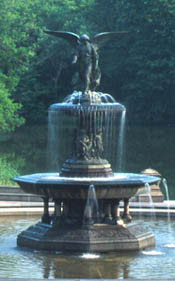 I've always been in awe of Central Park. Knowing the perniciousness (ooh! big word) of the American penchant for letting commercial properties expand their domain over whatever stands in their way, I’m shocked that it hasn’t been gobbled up by some developer during its 151 year history. Its exceptional existence is best realized with an aerial view. Someone had foresight. Someone had vision.
I've always been in awe of Central Park. Knowing the perniciousness (ooh! big word) of the American penchant for letting commercial properties expand their domain over whatever stands in their way, I’m shocked that it hasn’t been gobbled up by some developer during its 151 year history. Its exceptional existence is best realized with an aerial view. Someone had foresight. Someone had vision. It all started in 1853 when some of the wealthy residents of Manhattan put out the idea that a park should be created in New York City. They’d seen the lovely parks in London and Paris and wanted their own bragging rights in the United States. It could be a park where they could take carriage rides and where working class people could find recreation. In 1853, after three years of public debate, the city took over 700 acres of land via eminent domain (that’s when the state seizes private property—with compensation but without the owner’s consent—for public use.) What existed at the site at the time were poor neighborhoods. Sixteen hundred people had to move for the sake of the park. Irish pig farmers, German gardeners, and a vital African-American community called Seneca Village, were displaced for the greater good. But the 700 acres wasn’t great land to begin with—which is why it hadn’t been developed commercially. It was swampy and rugged, with rocky outcroppings. The original boundaries were Fifth to Eighth Avenues, from 59th and 106th streets. In 1863 it was extended to 110th Street, which brought Central Park up to its current 843 acres.
 |
| Bethesda Terrace under construction 1862 |
 |
| Bethesda Terrace today |
 Central Park became the first landscaped public park in the United States. Its design came about because of the country’s first landscape contest. The winners were Frederick Law Olmsted and Calvert Vaux.
Central Park became the first landscaped public park in the United States. Its design came about because of the country’s first landscape contest. The winners were Frederick Law Olmsted and Calvert Vaux. They also had to blast out solid rock to make the reservoirs and change the terrain. They used more gunpowder for blasting than was used in the (then future) Battle of Gettysburg. Over 20,000 men labored on the park, moving 3,000,000 cubic yards of soil and planting 270,000 trees and shrubs. Imagine all those seedlings and baby plants. The vista was obviously not as lush as it is now. But it was a beginning. The park officially opened in winter 1859, just in time for ice skating. Soon after, the park had over seven million visitors a year!
Yet originally, the park was bedeviled by rules of who could use it—and how. Group picnics were banned, and if you were a tradesman you couldn’t take your family on a ride in the park using the wagon you used for your business. If kids wanted to play ball? They had to have a note from the principal of their school! Stupid rules meant to keep the park pristine for the upper class. There was of course a public outcry and eventually the rules were eased. A zoo was added in 1871, a carousel, lawn tennis and such, making it much more democratic. Many changes (additions and deletions) have been made over the years, adapting to the times. The original Central Park Reservoir—that used to provide water to the city—was renamed the Jaqueline Kennedy Onassis Revervoir in 1994. Jackie O had an apartment overlooking the park and jogged there for years. Also, over 200 movies have been made using areas of the park. If you’ve seen the movies "Enchanted" (love the dance scene!), "Serendipity", "Breakfast at Tiffany’s", "When Harry Met Sally", "27 Dresses", and a myriad of “Law & Order” episodes . . . you’ve seen clips filmed in Central Park.
 |
| The Mall (Promenade) |




Hi Nancy -
ReplyDeleteThanks for the history lesson. I grew up in New York and didn't know these details. :)
Blessings,
Susan